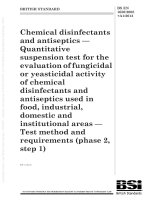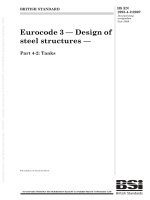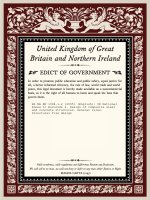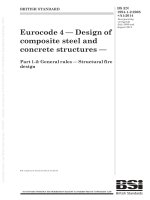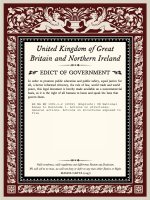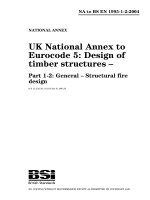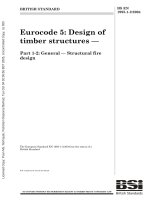Bsi bs en 61753 057 2 2013
Bạn đang xem bản rút gọn của tài liệu. Xem và tải ngay bản đầy đủ của tài liệu tại đây (1.23 MB, 28 trang )
BS EN 61753-057-2:2013
BSI Standards Publication
Fibre optic interconnecting
devices and passive
components — Performance
standard
Part 057-2: Single mode fibre
plug-receptacle style optical fuse
for category C — Controlled
environment
NO COPYING WITHOUT BSI PERMISSION EXCEPT AS PERMITTED BY COPYRIGHT LAW
raising standards worldwide™
BRITISH STANDARD
BS EN 61753-057-2:2013
National foreword
This British Standard is the UK implementation of EN 61753-057-2:2013. It is
identical to IEC 61753-057-2:2012.
The UK participation in its preparation was entrusted by Technical Committee
GEL/86, Fibre optics, to Subcommittee GEL/86/2, Fibre optic interconnecting
devices and passive components.
A list of organizations represented on this committee can be obtained on
request to its secretary.
This publication does not purport to include all the necessary provisions of a
contract. Users are responsible for its correct application.
© The British Standards Institution 2013
Published by BSI Standards Limited 2013
ISBN 978 0 580 70067 5
ICS 33.180.20
Compliance with a British Standard cannot confer immunity from
legal obligations.
This British Standard was published under the authority of the Standards
Policy and Strategy Committee on 30 April 2013.
Amendments issued since publication
Amd. No.
Date
Text affected
BS EN 61753-057-2:2013
EN 61753-057-2
EUROPEAN STANDARD
NORME EUROPÉENNE
EUROPÄISCHE NORM
March 2013
ICS 33.180.20
English version
Fibre optic interconnecting devices and passive components Performance standard Part 057-2: Single mode fibre plug-receptacle style optical fuse for
category C Controlled environment
(IEC 61753-057-2:2012)
Dispositifs d’interconnexion et
composants passives à fibres optiques Norme de performance Partie 057-2: Fusible optique du type à
fiche-embase à fibre unimodale pour
catégorie C Environnement contrôlé
(CEI 61753-057-2:2012)
Lichtwellenleiter Verbindungselemente und passive
Bauteile Betriebsverhalten Teil 057-2: Optische Sicherung für
Einmodenfasern in SteckverbinderBuchse-Bauform für die Kategorie C Kontrollierte Umgebung
(IEC 61753-057-2:2012)
This European Standard was approved by CENELEC on 2013-01-09. CENELEC members are bound to comply
with the CEN/CENELEC Internal Regulations which stipulate the conditions for giving this European Standard
the status of a national standard without any alteration.
Up-to-date lists and bibliographical references concerning such national standards may be obtained on
application to the CEN-CENELEC Management Centre or to any CENELEC member.
This European Standard exists in three official versions (English, French, German). A version in any other
language made by translation under the responsibility of a CENELEC member into its own language and notified
to the CEN-CENELEC Management Centre has the same status as the official versions.
CENELEC members are the national electrotechnical committees of Austria, Belgium, Bulgaria, Croatia, Cyprus,
the Czech Republic, Denmark, Estonia, Finland, Former Yugoslav Republic of Macedonia, France, Germany,
Greece, Hungary, Iceland, Ireland, Italy, Latvia, Lithuania, Luxembourg, Malta, the Netherlands, Norway, Poland,
Portugal, Romania, Slovakia, Slovenia, Spain, Sweden, Switzerland, Turkey and the United Kingdom.
CENELEC
European Committee for Electrotechnical Standardization
Comité Européen de Normalisation Electrotechnique
Europäisches Komitee für Elektrotechnische Normung
Management Centre: Avenue Marnix 17, B - 1000 Brussels
© 2013 CENELEC -
All rights of exploitation in any form and by any means reserved worldwide for CENELEC members.
Ref. No. EN 61753-057-2:2013 E
BS EN 61753-057-2:2013
EN 61753-057-2:2013
-2-
Foreword
The text of document 86B/3501/FDIS, future edition 1 of IEC 61753-057-2, prepared by SC 86B, "Fibre
optic interconnecting devices and passive components", of IEC TC 86, "Fibre optics" was submitted to the
IEC-CENELEC parallel vote and approved by CENELEC as EN 61753-057-2:2013.
The following dates are fixed:
•
•
latest date by which the document has
to be implemented at national level by
publication of an identical national
standard or by endorsement
latest date by which the national
standards conflicting with the
document have to be withdrawn
(dop)
2013-10-09
(dow)
2016-01-09
Attention is drawn to the possibility that some of the elements of this document may be the subject of
patent rights. CENELEC [and/or CEN] shall not be held responsible for identifying any or all such patent
rights.
Endorsement notice
The text of the International Standard IEC 61753-057-2:2012 was approved by CENELEC as a European
Standard without any modification.
-3-
BS EN 61753-057-2:2013
EN 61753-057-2:2013
Annex ZA
(normative)
Normative references to international publications
with their corresponding European publications
The following documents, in whole or in part, are normatively referenced in this document and are
indispensable for its application. For dated references, only the edition cited applies. For undated
references, the latest edition of the referenced document (including any amendments) applies.
NOTE When an international publication has been modified by common modifications, indicated by (mod), the relevant EN/HD
applies.
Publication
Year
Title
EN/HD
Year
IEC 60793-2-50
-
Optical fibres Part 2-50: Product specifications - Sectional
specification for class B single-mode fibres
EN 60793-2-50
-
IEC 60869-1
-
Fibre optic interconnecting devices and
passive components - Fibre optic passive
power control devices Part 1: Generic specification
EN 60869-1
-
IEC 61300-1
-
Fibre optic interconnecting devices and
passive components - Basic test and
measurement procedures Part 1: General and guidance
EN 61300-1
-
IEC 61300-2-1
-
Fibre optic interconnecting devices and
passive components - Basic test and
measurement procedures Part 2-1: Tests - Vibration (sinusoidal)
EN 61300-2-1
-
IEC 61300-2-2
-
Fibre optic interconnecting devices and
passive components - Basic test and
measurement procedures Part 2-2: Tests - Mating durability
EN 61300-2-2
-
IEC 61300-2-6
-
Fibre optic interconnecting devices and
EN 61300-2-6
passive components - Basic test and
measurement procedures Part 2-6: Tests - Tensile strength of coupling
mechanism
-
IEC 61300-2-9
-
Fibre optic interconnecting devices and
passive components - Basic test and
measurement procedures Part 2-9: Tests - Shock
EN 61300-2-9
-
IEC 61300-2-14
-
Fibre optic interconnecting devices and
passive components - Basic test and
measurement procedures Part 2-14: Tests - High optical power
EN 61300-2-14
-
IEC 61300-2-17
-
Fibre optic interconnecting devices and
passive components - Basic test and
measurement procedures Part 2-17: Tests - Cold
EN 61300-2-17
-
IEC 61300-2-18
-
Fibre optic interconnecting devices and
EN 61300-2-18
passive components - Basic test and
measurement procedures Part 2-18: Tests - Dry heat - High temperature
endurance
-
BS EN 61753-057-2:2013
EN 61753-057-2:2013
-4-
Publication
Year
Title
EN/HD
Year
IEC 61300-2-19
-
Fibre optic interconnecting devices and
passive components - Basic test and
measurement procedures Part 2-19: Tests - Damp heat (steady state)
EN 61300-2-19
-
IEC 61300-2-22
-
Fibre optic interconnecting devices and
passive components - Basic test and
measurement procedures Part 2-22: Tests - Change of temperature
EN 61300-2-22
-
IEC 61300-3-2
-
Fibre optic interconnecting devices and
EN 61300-3-2
passive components - Basic test and
measurement procedures Part 3-2: Examinations and measurements Polarization dependent loss in a single-mode
fibre optic device
-
IEC 61300-3-3
-
Fibre optic interconnecting devices and
passive components - Basic test and
measurement procedures Part 3-3: Examinations and measurements Active monitoring of changes in attenuation
and return loss
EN 61300-3-3
-
IEC 61300-3-4
-
Fibre optic interconnecting devices and
passive components - Basic test and
measurement procedures Part 3-4: Examinations and measurements Attenuation
EN 61300-3-4
-
IEC 61300-3-6
-
Fibre optic interconnecting devices and
passive components - Basic test and
measurement procedures Part 3-6: Examinations and measurements Return loss
EN 61300-3-6
-
IEC 61300-3-7
-
Fibre optic interconnecting devices and
passive components - Basic test and
measurement procedures Part 3-7: Examinations and measurements Wavelength dependence of attenuation and
return loss of single mode components
EN 61300-3-7
-
IEC 61300-3-28
-
Fibre optic interconnecting devices and
EN 61300-3-28
passive components - Basic test and
measurement procedures Part 3-28: Examinations and measurements Transient loss
-
IEC 61300-3-32
-
Fibre optic interconnecting devices and
EN 61300-3-32
passive components - Basic test and
measurement procedures Part 3-32: Examinations and measurements Polarisation mode dispersion measurement
for passive optical components
-
IEC 61754
Series Fibre optic connector interfaces
EN 61754
Series
IEC 61755
Series Fibre optic connector optical interfaces
EN 61755
Series
IEC/TR 62627-02
2010
Fibre optic interconnecting devices and
passive components Part 02: Report of round robin test results on
SC plug style fixed attenuators
-
BS EN 61753-057-2:2013
–2–
61753-057-2 © IEC:2012(E)
CONTENTS
INTRODUCTION ..................................................................................................................... 5
1
Scope ............................................................................................................................... 6
2
Normative references ....................................................................................................... 6
3
Tests ................................................................................................................................ 7
4
Test reports ...................................................................................................................... 8
5
Performance requirements ............................................................................................... 8
5.1
5.2
5.3
Annex A
Sample size, sequencing and grouping.................................................................... 8
Dimensions ............................................................................................................. 8
Test details and requirements ................................................................................. 8
(normative) Sample size and product sourcing requirements ................................. 16
Annex B (normative) Threshold powers for optical fuses ...................................................... 17
Annex C (normative) Reference connector and adaptor ....................................................... 18
Annex D (informative) Example of style configuration for optical fuse ................................... 19
Annex E (normative) Testing of optical fuses ....................................................................... 20
Bibliography .......................................................................................................................... 23
Figure D.1 – Optical fuse, plug-receptacle style configuration ............................................... 19
Figure E.1 – Test set-up schematics ..................................................................................... 20
Figure E.2 – Example of power threshold and blocking attenuation at threshold
measurements for sample 1280A of an optical fuse .............................................................. 21
Figure E.3 – Response time curve of an optical fuse ............................................................. 21
Figure E.4 – Response time testing set-up ............................................................................ 22
Table 1 – Performance requirements for optical fuses ............................................................. 8
Table A.1 – Sample size and product sourcing requirements ................................................ 16
Table B.1 – Powers for optical fuses, single-mode ................................................................ 17
Table C.1 – Requirements for reference connector and adaptor ............................................ 18
BS EN 61753-057-2:2013
61753-057-2 © IEC:2012(E)
–5–
INTRODUCTION
The International Electrotechnical Commission (IEC) draws attention to the fact that it is
claimed that compliance with this document may involve the use of a patent concerning
optical fuse.
IEC takes no position concerning the evidence, validity and scope of this patent right.
The holder of this patent right has assured the IEC that he/she is willing to negotiate licences
either free of charge or under reasonable and non-discriminatory terms and conditions with
applicants throughout the world. In this respect, the statement of the holder of this patent right
is registered with IEC. Information may be obtained from:
KiloLambda technologies, Ltd.
22a Wallenberg street,
Tel-Aviv 69719, Israel
Attention is drawn to the possibility that some of the elements of this document may be the
subject of patent rights other than those identified above. IEC shall not be held responsible for
identifying any or all such patent rights.
ISO (www.iso.org/patents) and IEC () maintain on-line data bases of
patents relevant to their standards. Users are encouraged to consult the data bases for the
most up to date information concerning patents.
US patent US-7162,114 B2 "Optical Energy switching device and method", granted
January 9,2007.
Japan patent 4376632 "Optical Energy switching device and method", granted September 18,
2009
The optical fuse is a passive device, designed to protect equipment and fibre cables from
damage due to optical overpower, spikes and surges. The optical fuse produces a controlled,
permanent, signal blocking at a predetermined power threshold in an optical fibre
transmission line. The optical fuse is wavelength independent over its entire specified spectral
range. IEC 60869-1 contains the generic information of the optical fuse. The optical fuse has
a maximum allowed power input Pin max that is allowed. Beyond this power it is dysfunctional
and can let light through. Numerical values for Pin max are given in Annex B.
BS EN 61753-057-2:2013
–6–
61753-057-2 © IEC:2012(E)
FIBRE OPTIC INTERCONNECTING DEVICES
AND PASSIVE COMPONENTS –
PERFORMANCE STANDARD –
Part 057-2: Single mode fibre plug-receptacle
style optical fuse for category C –
Controlled environment
1
Scope
This part of IEC 61753 contains the minimum initial test and measurement requirements and
severities which a fibre optical fuse satisfies in order to be categorised as meeting the
requirements of single mode fibre plug-receptacle style optical fuse used in controlled
environments. Optical performance specified in this document relate to plug-receptacle style
configuration fuses only.
2
Normative references
The following documents, in whole or in part, are normatively referenced in this document and
are indispensable for its application. For dated references, only the edition cited applies. For
undated references, the latest edition of the referenced document (including any
amendments) applies.
IEC 60793-2-50, Optical fibres – Part 2-50: Product specifications – Sectional specification for
class B single-mode fibres
IEC 60869-1, Fibre optic interconnecting devices and passive components – Fibre optic
passive power control devices – Part 1: Generic specification 1
IEC 61300-1, Fibre optic interconnecting devices and passive components – Basic test and
measurement procedures – Part 1: General and guidance
IEC 61300-2-1, Fibre optic interconnecting devices and passive components – Basic test and
measurement procedures – Part 2-1: Tests – Vibration (sinusoidal)
IEC 61300-2-2, Fibre optic interconnecting devices and passive components – Basic test and
measurement procedures – Part 2-2: Tests – Mating durability
IEC 61300-2-6, Fibre optic interconnecting devices and passive components – Basic test and
measurement procedures – Part 2-6: Tests – Tensile strength of coupling mechanism
IEC 61300-2-9, Fibre optic interconnecting devices and passive components – Basic test and
measurement procedures – Part 2-9: Tests – Shock
IEC 61300-2-14, Fibre optic interconnecting devices and passive components – Basic test
1
and measurement procedures – Part 2-14: Tests – High optical power
IEC 61300-2-17, Fibre optic interconnecting devices and passive components – Basic test
and measurement procedures – Part 2-17: Tests – Cold
___________
1
To be published.
BS EN 61753-057-2:2013
61753-057-2 © IEC:2012(E)
–7–
IEC 61300-2-18, Fibre optic interconnecting devices and passive components – Basic test
and measurement procedures – Part 2-18: Tests – Dry heat – High temperature endurance
IEC 61300-2-19, Fibre optic interconnecting devices and passive components – Basic test
and measurement procedures – Part 2-19: Tests – Damp heat (steady state)
IEC 61300-2-22, Fibre optic interconnecting devices and passive components – Basic test
and measurement procedures – Part 2-22: Tests – Change of temperature
IEC 61300-3-2, Fibre optic interconnecting devices and passive components – Basic test and
measurement procedures – Part 3-2: Examinations and measurements – Polarization
dependent loss in a single-mode fibre optic device
IEC 61300-3-3, Fibre optic interconnecting devices and passive components – Basic test and
measurement procedures – Part 3-3: Examinations and measurements – Active monitoring of
changes in attenuation and return loss
IEC 61300-3-4, Fibre optic interconnecting devices and passive components – Basic test and
measurement procedures – Part 3-4: Examinations and measurements – Attenuation
IEC 61300-3-6, Fibre optic interconnecting devices and passive components – Basic test and
measurement procedures – Part 3-6: Examinations and measurements – Return loss
IEC 61300-3-7, Fibre optic interconnecting devices and passive components – Basic test and
measurement procedures – Part 3-7: Examinations and measurements – Wavelength
dependence of attenuation and return loss of single mode components
IEC 61300-3-28, Fibre optic interconnecting devices and passive components – Basic test
and measurement procedures – Part 3-28: Examinations and measurements – Transient loss
IEC 61300-3-32, Fibre optic interconnecting devices and passive components – Basic test
and measurement procedures – Part 3-32: Examinations and measurements – Polarization
mode dispersion measurement for passive optical components
IEC 61754 series, Fibre optic connector interfaces
IEC 61755 series, Fibre optic connector optical interfaces
IEC/TR 62627-02:2010, Fibre optic interconnecting devices and passive components – Part
02: Report of round robin test results on SC plug style fixed attenuators
3
Tests
All test methods are in accordance with the IEC 61300 series.
Some tests require the use of reference connector plugs and reference connector adaptors.
These are specified in Annex C. It is essential and recommended that all connector, plugs and
reference connector adaptors be inspected and cleaned if dirty and checked again, according
to manufacturers’ instructions, prior to every mating in all tests.
All tests are to be carried out to validate performance over the required operating wavelength
and power range. As a result, single or multiple spectral bands may be chosen for the
qualification in addition to threshold power.
BS EN 61753-057-2:2013
–8–
4
61753-057-2 © IEC:2012(E)
Test reports
Fully documented test reports and supporting evidence shall be prepared and shall be
available for inspection as evidence that the tests have been carried out and complied with.
5
Performance requirements
5.1
Sample size, sequencing and grouping
Sample sizes for the tests are defined in Annex A.
5.2
Dimensions
Dimensions of mechanical interface for mating, plug and receptacle size, shall comply with
IEC optical connector interface standard IEC 61754 series and IEC optical interface standard
IEC 61755 series. Other dimensions shall comply with those given in appropriate
manufacturer's drawings.
When implementing this standard be aware that there have been problems when using a rigid
interface component with SC plug style adaptors and plugs. See Clause 6 of
IEC/TR 62627-02:2010.
5.3
Test details and requirements
Table 1 specifies the optical, environment and mechanical performance requirements and
related test methods for optical fuses.
Compliance to this standard requires demonstration of the ability to meet the performance
requirement in Table 1.
Table 1 – Performance requirements for optical fuses (1 of 8)
No.
1
Test
Insertion
loss
Requirement
Details
Operating wavelength
range: 1 520 nm to
1 625 nm
Method:
IEC 61300-3-7, Method B2.1, test sample
configuration according to IEC 61300-3-4
substitution method
Insertion loss ≤1,5 dB
Launch
patchcord length:
≥ 2 m. Only the fundamental mode shall
propagate at the fuse interface and at the
detector.
Other
requirements:
This test shall be performed against a
reference plug 1, 2 and reference adaptor.
Launch
conditions:
The wavelength of the source shall be
longer than cut-off wavelength of the fibre.
Source power
stability:
≤ ± 0,05 dB over the measuring period or
at least 1 h
Wavelength
range:
1 520 nm to 1 625 nm
Total uncertainty
≤ ± 0,05 dB
Insertion loss is measured
with input power ≤ –5 dBm
BS EN 61753-057-2:2013
61753-057-2 © IEC:2012(E)
–9–
Table 1 (2 of 8)
No.
2
Test
Requirement
Return loss
Below power
threshold
Details
Method:
≥ 35 dB Grade T
≥ 40 dB Grade R
IEC 61300-3-6 (Against
2 reference plugs 1 )
measurement method 1,
OFDR for grade V
≥ 50 dB Grade U
≥ 60 dB Grade V
Return loss is measured with input
power ≤ –5 dBm
3
4
Return loss
≥ 30 dB
Above power
threshold, after
fuse response
Return loss is measured with input
power ≤ –5 dBm
Polarization
Dependent Loss
≤ 0,2 dB
Over the specified operating
wavelength
The samples shall be terminated onto
single-mode fibres as per
IEC 60793-2-50, Type B 1.1, in either
coated fibres (primary and secondary)
or reinforced cable format
5
6
Polarization mode
dispersion
≤ 0,2 ps (Max value)
Over the specified operating
wavelength range
High optical
power
The fuse will not change its insertion
and return loss up to power threshold
Below power
threshold
Before and after the test the Insertion
loss shall meet the requirements of
test 1
Before and after the test the return
loss shall meet the requirements of
test 2
The insertion loss change during the
test shall be within ± 0,5 dB of the
initial value.
IEC 61300-3-6 (Against
2 reference plugs 1 )
measurement method 1,
OCWR for grades T,R, U
Optical source
Wavelength:
1 520 nm and 1 625 nm
Test every sample with
the two wavelengths.
Total
uncertainty
≤ ± 2 dB
Method:
IEC 61300-3-6 (Against
2 reference plugs 1 )
measurement method 1,
OCWR
Optical source
Wavelength:
1 520 nm and 1 625 nm
Test every sample with
the two wavelengths.
Total
uncertainty
≤ ±2 dB
Method:
IEC 61300-3-2 , all
polarization method
Optical source
Wavelength:
1 550 nm ± 10 nm
Total
uncertainty
≤ ±0,05 dB over the
dynamic range to be
measured
Method:
IEC 61300-3-32, MPS
method
Optical source
Wavelength:
1 550 nm ± 10 nm
Detector
linearity:
± 0,05 dB over the
dynamic range to be
measured
Method:
IEC 61300-2-14
Optical source
Wavelength:
1 550 nm ± 10 nm
Test power:
3 dB below power
threshold
Test
temperature:
25 °C ± 2 °C
Test duration:
Duration of long-term test:
96 h at test power
BS EN 61753-057-2:2013
– 10 –
61753-057-2 © IEC:2012(E)
Table 1 (3 of 8)
No.
7
Test
High optical
power
Above power
threshold
(Destructive
test)
Requirement
The fuse will block the
power from power threshold
to ≥ 30 dBm input power or
higher value specified in
Annex B
Before the test the Insertion
loss shall meet the
requirements of test 1
Details
Method:
IEC 61300-2-14
Optical source
Wavelength:
1 550 nm ± 10 nm
Test power:
3 dB above power threshold
Test temperature:
25 °C ± 2 °C
Test duration:
Duration of long-term test: 96 h
at test power
Method:
See Annex E for detailed test
description.
After and during the test the
Insertion loss shall meet the
requirements of test 9
Before and after the test the
return loss shall meet the
requirements of test 2
8
Power
threshold
(Destructive
test)
The tolerance is ± 1 dB
from the specified optical
fuse power threshold
The test power input is 1 dB to
3 dB above power threshold and
the blocking attenuation is
measured accordingly.
The fuse will meet the
power threshold
requirements as specified
when operated at the
3 specified temperatures
Samples from every batch will be
destructively tested, all will
comply.
Optical source
Wavelength:
1 550 nm
Test temperature:
10 °C ± 2 °C
25 °C ± 2 °C
60 °C ± 2 °C
9
Blocking
attenuation at
threshold
(destructive
test)
> 30 dB
Method:
The fuse will meet the
requirement as specified,
when operated at the
3 specified temperatures for
the specified duration
See Annex E for detailed test
description.
The test power input is 1 dB to
3 dB above power threshold and
the blocking attenuation is
measured accordingly.
Samples from every batch will be
destructively tested, all will
comply.
Optical source
Wavelength:
1 550 nm
Test duration:
96 h at test power
Test temperature:
10 °C ± 2 °C
25 °C ± 2 °C
60 °C ± 2 °C
BS EN 61753-057-2:2013
61753-057-2 © IEC:2012(E)
– 11 –
Table 1 (4 of 8)
No.
Test
10
Response time
Requirement
< 100 µs
Details
Method:
The fuse will meet the
requirement as specified,
when operated at the 3
specified temperatures
See Annex E for detailed test
description.
The test power input is 1 dB to
3 dB above power threshold and
the blocking attenuation is
measured accordingly.
Samples from every batch will be
destructively tested, all will
comply.
Optical source
Wavelength:
1 550 nm
Test temperature:
10 °C ± 2 °C
25 °C ± 2 °C
60 °C ± 2 °C
11
Damp heat
(steady state)
By the end of the test the
insertion loss shall meet the
requirements of test 1
By the end of the test the
return loss shall meet the
requirements of test 2
The insertion loss change
during the test shall be
within ± 0,5 dB of the initial
value. Insertion loss is
measured with input power
≤ –5 dBm
After the test the power
threshold shall meet the
requirements of test 8
Method:
IEC 61300-2-19
During the test the change in
Insertion loss shall be measured
by test method IEC 61300-3-3.
Pre conditioning
procedure:
Standard atmospheric conditions
as defined in IEC 61300-1 for
2 hours
Temperature:
+ 40 ± 2 °C
Relative Humidity:
93 %
Duration of
exposure:
96 h
Specimen optically
functioning:
Yes
Optical source
Wavelength:
1 550 nm
Optical power:
3 dB lower than power threshold,
as defined in Annex B
Recovery
procedure:
Allow specimens to return to
standard atmospheric conditions
defined in IEC 61300-1 in 2 h.
+ 2 RH
−3
BS EN 61753-057-2:2013
– 12 –
61753-057-2 © IEC:2012(E)
Table 1 (5 of 8)
No.
12
Test
Change of
temperature
Requirement
By the end of the test the
Insertion loss shall meet the
requirements of test 1
By the end of the test the
return loss shall meet the
requirements of test 2
The insertion loss change
during the test shall be within
± 0,5 dB of the initial value.
Insertion loss is measured
with input power ≤ –5 dBm
After the test the power
threshold shall meet the
requirements of test 8
13
Dry heat-high
temperature
endurance
By the end of the test the
insertion loss requirements of
test No. 1 shall be met
By the end of the test the
return loss requirement of test
No. 2 shall be met
The insertion loss change
during the test shall be within
± 0,5 dB of the initial value.
Insertion loss is measured
with input power ≤ –5 dBm
After the test the power
threshold shall meet the
requirements of test 8
Details
Method:
IEC 61300-2-22
During the test the change in
Insertion loss shall be measured
by test method IEC 61300-3-3.
Pre conditioning
procedure:
Standard atmospheric conditions
as defined in IEC 61300-1 for 2 h
High
Temperature:
+60 ± 2 °C
Low temperature:
–10 ± 2 °C
Number of
cycles:
5
Temperature rate
of change:
1 °C/min
Duration at
extreme
temperatures:
1h
Specimen
optically
functioning:
Yes
Optical source
Wavelength:
1 550 nm
Optical power:
3 dB lower than power threshold,
as defined in Annex B
Maximum
sampling interval
during the test:
15 min
Recovery
procedure:
Allow specimen to return to
standard atmospheric conditions
in IEC 61300-1 for in 2 h.
Method:
IEC 61300-2-18
During the test the change in
insertion loss shall be measured.
By test method IEC 61300-3-3.
Pre-conditioning
procedure:
Standard atmospheric conditions
as defined in IEC 61300-1 for 2 h
Specimen
optically
functioning:
Yes
Temperature:
+60 °C ± 2 °C
Duration of the
exposure:
96 h
Optical source
Wavelength:
1 550 nm
Maximum
sampling interval
during the test:
1h
Recovery
procedure:
Allow specimen to return to
standard atmospheric conditions
in IEC 61300-1 for in 2 h.
BS EN 61753-057-2:2013
61753-057-2 © IEC:2012(E)
– 13 –
Table 1 (6 of 8)
No.
14
Test
Cold
Requirement
By the end of the test the
Insertion loss shall meet the
requirements of test 1
By the end of the test the
return loss shall meet the
requirements of test 2
The insertion loss change
during the test shall be within
± 0,5 dB of the initial value.
Insertion loss is measured
with input power ≤ –5 dBm
After the test the power
threshold shall meet the
requirements of test 8
15
Vibration
(sinusoidal)
After the test the insertion
loss shall meet the
requirements of test 1
After the test the return loss
shall meet the requirements
of test 2
The insertion loss change
between value before test and
value after test shall be within
± 0,5 dB of the initial value.
Insertion loss is measured
with input power ≤ –5 dBm
After the test the power
threshold shall meet the
requirements of test 8
Details
Method:
IEC 61300-2-17
During the test the change in
Insertion loss shall be measured
by test method IEC 61300-3-3.
Pre-conditioning
procedure:
Standard atmospheric conditions
as defined in IEC 61300-1 for 2 h
Specimen
optically
functioning:
Yes
Temperature:
–10 °C ± 2 °C
Duration of the
exposure:
96 h
Optical source
Wavelength:
1 550 nm
Optical power:
3 dB lower than power threshold,
as defined in Annex B
Maximum
sampling interval
during the test:
1h
Recovery
procedure:
Allow specimen to return to
standard atmospheric conditions
in IEC 61300-1 for in 2 h.
Method:
IEC 61300-2-1
During the test the change in
Insertion loss shall be measured
by test method IEC 61300-3-3.
Frequency
range:
10 Hz to 55 Hz
Vibration
amplitude:
0,75 mm
Number of
cycles:
15
Rate of change:
1 octave/min
Number of axes:
3 orthogonal axes
Specimen
optically
functioning:
No
Optical source
Wavelength:
1 550 nm
Optical power:
3 dB lower than power threshold,
as defined in Annex B
BS EN 61753-057-2:2013
– 14 –
61753-057-2 © IEC:2012(E)
Table 1 (7 of 8)
No.
16
Test
Shock
Requirement
After the test the insertion
loss shall meet the
requirements of test 1
After the test the return loss
shall meet the requirements
of test 2
After the test the power
threshold shall meet the
requirements of test 8
Before and after the test
specimen tested in mated
position
17
Strength of
coupling
mechanism
After the test the insertion
loss shall meet the
requirements of test 1
After the test the return loss
shall meet the requirements
of test 2
The insertion loss change
during the test shall be within
± 0,5 dB of the initial value.
Above measurements carried
out in power ≤ –5 dBm
18
Mating
durability
After the test the return loss
shall meet the requirements
of test 2
The insertion loss change
during the test shall be within
± 0,5 dB of the initial value.
Above measurements carried
out in power ≤ –5 dBm
Return loss is measured with
input power ≤ –5 dBm
Details
Method:
IEC 61300-2-9
Acceleration
force:
500 g
Number of axes:
3 axes, 2 directions
Number of
cycles:
2 shocks per direction,
12 shocks total
Duration per
axis:
Nominal 1 ms duration, half sine
pulse
Measurements
required:
Before, after each axis, and after
the test
Specimen
optically
functioning:
No
Optical source
Wavelength:
1 550 nm
Optical power:
3 dB lower than power threshold,
as defined in Annex B
Method:
IEC 61300-2-6
During the test the change
insertion loss shall be measured
by transient loss test method
IEC 61300-3-28 (Transient loss).
Magnitude of the
load:
40 N, at a rate of 2 N/s
Load application
point:
0,2 m from the optical interface
Duration of the
load:
120 s
Specimen
optically
functioning:
Yes
Optical power:
3 dB lower than power threshold,
as defined in Annex B
Optical source
Wavelength:
1 550 nm
Method:
IEC 61300-2-2
Number of
mating cycles:
200, all parts (connector fuseadaptor-connector) shall be
demated and mated
Specimen
optically
functioning:
Yes
Measurements
required:
Change in insertion loss shall be
measured after every cycle;
Before and after the test the
insertion loss shall meet the
requirements of test 1.
Return loss shall be measured
before and after the test and
shall meet the requirements of
test 2.
Optical source
Wavelength:
1 550 nm
BS EN 61753-057-2:2013
61753-057-2 © IEC:2012(E)
– 15 –
Table 1 (8 of 8)
No.
Test
Requirement
Details
Other
specifications:
Preconditioning procedure: clean
plug and adaptor according to
manufacturer’s instructions.
In situ conditioning procedure:
clean the mechanical and optical
alignment parts of the moving
connector according to the
manufacturer instructions after
cycle 24, 74, 124, and 174.
Clean both the moving and
stationary connectors and
adaptor according to the
manufacturer instructions after
cycle 49, 99, 149, and 199. No
additional cleaning or re-cleaning
is allowed.
Recovery procedure: the
mechanical and optical alignment
parts of the specimen may be
cleaned according to
manufacturer instructions up to 2
times after the final mating cycle.
1
2
Reference connector definition is given in Annex C.
Clean connectors, plugs and adaptors according to manufacturer's instructions, prior to every mating, in all
tests unless otherwise specified.
BS EN 61753-057-2:2013
– 16 –
61753-057-2 © IEC:2012(E)
Annex A
(normative)
Sample size and product sourcing requirements
Table A.1 gives sample size and product sourcing requirements.
Table A.1 – Sample size and product sourcing requirements
No.
Test
Sample size
Source
N/A
Dimensional
10
New
1
Insertion loss
80
New
2
Return loss below power threshold
80
Test 1
3
Return loss above power threshold
12
Test 8 or 9
4
Polarization dependent loss
4
Test 2
5
Polarization mode dispersion
4
Test 4
6
High optical power. Below power threshold
8
Test 5
7
High optical power. Above power threshold. (Destructive test)
4
Test 2
8
Power threshold (Destructive test)
4 samples at each temperature
12
Test 2
Blocking attenuation at threshold (Destructive test)
12
Test 2
10
9
Response time (Destructive test)
12
Test 2
11
Damp Heat (steady state)
4
Test 2
12
Change of temperature
4
Test 2
13
Dry heat
4
Test 2
14
Cold
4
Test 2
15
Vibration (sinusoidal)
4
Test 2
16
Shock
4
Test 2
17
Strength of coupling mechanism
4
Test 2
18
Mating durability
4
Test 2
NOTE Tests 5 to 18 may be performed in any order. Samples for tests 5 to 18 should be randomly selected
from the samples of tests 2 and 4. Some tests are destructive and the samples cannot be used for any further
testing. Tests 8 and 9 are performed on the same samples or on different samples.
BS EN 61753-057-2:2013
61753-057-2 © IEC:2012(E)
– 17 –
Annex B
(normative)
Threshold powers for optical fuses
Table B.1 gives the powers for optical fuses, single-mode.
Table B.1 – Powers for optical fuses, single-mode
dBm
Recommended power
for normal CW work
dBm
Maximum allowed
power input, P in max
dBm
18
Up to 15
Up to 30
19
Up to 16
Up to 32
20
Up to 17
Up to 34
21
Up to 18
Up to 36
22
Up to 19
Up to 36
23
Up to 20
Up to 36
24
Up to 21
Up to 36
25
Up to 22
Up to 36
26
Up to 23
Up to 36
27
Up to 24
Up to 36
28
Up to 25
Up to 36
29
Up to 26
Up to 36
30
Up to 27
Up to 36
Power threshold
NOTE P in max of 36 dBm is the maximum allowed power input into an optical fuses having power threshold up to
30 dBm. Beyond this power, P in max of 36 dBm, it is dysfunctional and can let light through.
BS EN 61753-057-2:2013
– 18 –
61753-057-2 © IEC:2012(E)
Annex C
(normative)
Reference connector and adaptor
Table C.1 gives the requirements for the reference connector and the adaptor.
Table C.1 – Requirements for reference connector and adaptor
Items
2,5 mm diameter ferrule
PC connector
1,25 mm diameter ferrule
PC connector
Ferrule outer diameter
2,499 mm ± 0,000 5 mm
1,249 mm ± 0,000 5 mm
Eccentricity of fibre core centre to ferrule centre
≤ 0,3 µm
≤ 0,3 µm
Deviation of axis of fibre to axis of ferrule
≤ 0,2 degree
≤ 0,2 degree
Eccentricity of spherically polished ferrule
endface
≤ 50 µm
≤ 50 µm
Visual examination of fibre end surface with x200
magnification
No defects in core zone
No defects in core zone
Insertion Loss between two reference plugs
≤ 0,2 dB
≤ 0,2 dB
Visual examination
Every 50 mating
Every 50 mating
NOTE
Reference adaptors should give 0,2 dB maximum insertion loss when used with two reference plugs.
BS EN 61753-057-2:2013
61753-057-2 © IEC:2012(E)
– 19 –
Annex D
(informative)
Example of style configuration for optical fuse
The optical fuse, plug-receptacle style, configuration is given in Figure D.1.
IEC
2270/12
Figure D.1 – Optical fuse, plug-receptacle style configuration
BS EN 61753-057-2:2013
– 20 –
61753-057-2 © IEC:2012(E)
Annex E
(normative)
Testing of optical fuses 2
E.1
Introductory remark
This annex describes the testing of optical fuse functionality and measurement of its
parameters. Testing of the following parameters, which do not appear in regular IEC
standards, is described:
•
power threshold;
•
blocking attenuation at threshold;
•
response time.
The fuse is a safety device and only destructive testing can test its functionality; it is not
functional any more after exposure to powers over the threshold. The actual test requires high
power, and needs a dedicated test set up, designed for these measurements.
An example of a test carried out on an optical fuse will be followed according to this Annex,
where the optical fuse parameters are
–
power threshold: (each fuse in the batch)
20 dBm ± 1 dB
–
blocking attenuation at threshold
> 30 dB
–
response time:
< 100 µs
E.2
Power threshold and blocking attenuation at threshold measurement
Measuring the threshold power is the first and most important functional test of the optical
fuse, calling to expose the rated, e.g. 20 dBm, optical fuse to slowly varying powers starting at
10 dBm and up to 36 dBm. The powers needed call for an oscillator (e.g. diode laser) followed
by fibre amplifiers.
IEC
2266/12
Figure E.1 – Test set-up schematics
The power measured by the detector, as a function of input power, provides both the
threshold power as well as the blocking attenuation at the threshold of the DUT. The insertion
loss for low and high power is provided as well.
Figure E.2 shows a curve of the change of the IL against the P in. The change of the IL that
occurs at threshold can be seen, the IL change from ~0 dB to > 50 dB, giving more than five
orders of magnitude "protection", or blocking attenuation at threshold, being > 30 dB needed
in this example. The values of the insertion loss before and after activation are part of the
collected results.
___________
2
This Annex will be deleted when an IEC standard for a test method for an optical fuse is published.
BS EN 61753-057-2:2013
61753-057-2 © IEC:2012(E)
– 21 –
80
70
60
IL (dB)
50
40
30
20
10
0
10
12
14
16
Pin (dBm)
18
20
22
IEC 2267/12
Figure E.2 – Example of power threshold and blocking attenuation
at threshold measurements for sample 1280A of an optical fuse
E.3
Response time measurement
The response time of the optical fuse is defined as the total time where the optical fuse output
power level is higher than the predetermined optical fuse power threshold by +1 dB. Here the
input pulse duration is 1 ms long, having rise time of ~10 µs and a steady state power of fuse
power threshold + 3 dB. Figure E.3 illustrates the parameters.
In this case, rise time is the elapsed time for input power to reach 90 % of its steady-state
value from the time it starts.
Power
Response
time
Power in
Power out
Power threshold +3 dB
Power threshold +1 dB
Power threshold
Time
1 ms input pulse time
IEC 2268/12
Figure E.3 – Response time curve of an optical fuse
BS EN 61753-057-2:2013
– 22 –
61753-057-2 © IEC:2012(E)
Schematics of the test set-up and description are shown in Figure E.4.
IEC
2269/12
Figure E.4 – Response time testing set-up
A 1 550 nm wavelength laser provides the input signal, which is amplified and regenerated by
the optical pulse generator unit, controlled by a designated software program. Output power is
measured and presented graphically using an oscilloscope. Analysis of the data is carried out
using standard mathematical software.
Since the test is carried out at three different temperatures, the minimal specified temperature,
the maximal specified temperature and the average specified temperature of the optical fuse,
the DUT is placed in a thermal chamber having stable temperature as required.
